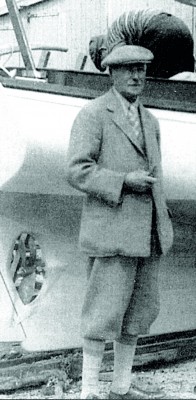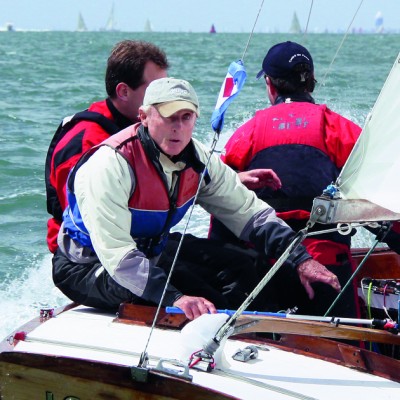The X One Design may have had its centenary a few years ago, but it is still one of the mostly hotly contested and the biggest of the keelboat classes at Cowes. Elaine Bunting looks at its history
“They’ll talk to you nicely over tea,” I’m told, “but they’ll have your guts for garters round the cans.”
The X is a pretty-looking, yet robust Edwardian design whose only flaws, claim its fans, are that it is time-consuming to maintain and very wet to race. You could say the same about any number of older one-designs, some even more venerable than the X, which celebrated its Centenary in 2011, but this one has flourished to become one of most hotly contested fleets in the world.
For years the X – also known as X boats or XODs – has been the biggest class at Cowes Week. In its Centenary year a fleet of over 100 boats raced at Cowes, setting a new record for the largest class ever at the regatta.

Nick Dorley-Brown, owner of X115 Mix at the helm during Cowes Week, with his cew Nick Hayward and Dug Henderson
The X boats can look quaintly historic to outsiders, but sailors who migrate to them from more high-tech classes and expect to be competitive are liable to get a sharp surprise. The X is notoriously tricky to set up and insinuate to the front of the pack.
Skippers tend to be as long-lasting as their boats and it would be foolish to underestimate them. Some of the most skilled sailors in the class are well into their 70s and 80s, race twice a week and are harder to catch than a ferret.
Start of the class
But to start at the beginning, the X was designed and built for the Motor Yacht Club (later the Royal Motor Yacht Club) in Poole by Alfred Westmacott (see also the Victory class). The prototype, named Mistletoe, was built at his yard, Woodnutt & Co at St Helens on the Isle of Wight. She now lives in the National Maritime Museum.
The club ordered four more in 1910, including Madcap (X5, and today the oldest remaining X) and the first race was held off Hythe on 3 June 1911.
During the 1920s the class expanded. New boats were built at Woodnutts, at Berthon in Lymington, Kemp in Hythe and Newmans in Poole. As the class grew, there were discussions and controversy about whether to modernise and after much debate the gaff rig was replaced with a bermudan rig in 1928.
After the war boats continued to be built at a steady rate of one or two a year. There was, and still is, regular club racing at Poole, Lymington, Yarmouth, Cowes, Hamble and Itchenor and by 1961 more than 50 Xs competed at Cowes Week.

X boats racing during Cowes Week in 1958, with poled out leg o’ mutton sails set to windward of the jib, but sheeted to windward of the forestay. The class allowed parachute spinnakers in 1971
This was the start of the X’s reign as the largest one-design class and only a brief interregnum by the SB3s between 2005 and 2007 has ever eclipsed it.
Grand masters
The ultimate achievement for any X boat crew is to win the Captain’s Cup, awarded to the victor at Cowes Week. Some argue that it is the hardest trophy to win across all the competing classes.
If so, Stuart Jardine is Cowes Week’s Jedi Master. The undisputed top dog of the XOD class, Jardine, from Lymington, has won the Captain’s Cup eight times in his boat Lone Star, X119. In one of the few gaps in his supremacy in 2003, the Cup was lifted by his twin brother, Ado.
Experience of the X’s quirks is said to be fundamental to winning, so it is worth mentioning that Stuart Jardine and his brother Ado are now in their eighties. The Jardines began sailing in X boats in 1942 in Jaffa where their father, an Army officer, was posted. “Very soon Dad discovered that we were better at helming than him,” Stuart remembers.
Jardine did Olympic campaigns in the Star class in Mexico 1968 and in Germany in 1972, but later returned to the X. His record in it is unparalleled and probably unlikely ever to be repeated, though it lends weight to the assertion that skippers can get better and better even as age creeps up on them.
“A lot of people in the class have retired so they have more time to sail,” explains Jardine. “I’m sure my sailing has improved since I stopped working.”
See Stuart Jardine’s advice on winning at Cowes here
Like any old boat, the Xs have their individual as well as collective quirks. Early boats built at Woodnutts and later at Newmans were often built by eye and the measurements vary slighty.

Some Xs were used as day boats or even converted out of class. This was a family outing in Sarine in 1959. Photo: Beken of Cowes
“They are all slightly different mainly because of minor mistakes,” says class measurer John Wilson. “Some deck beams are deeper or wider, for example, and all the transoms are a little different. The Newmans are a bit longer so they are quicker in flat water, especially downwind.
“The class has accepted that many don’t strictly conform and all the boats built before 1964 have been ‘grandfathered’ and are accepted to race,” he says.






